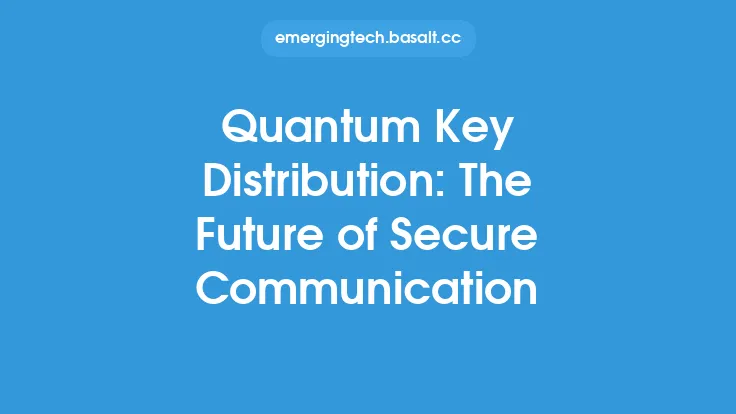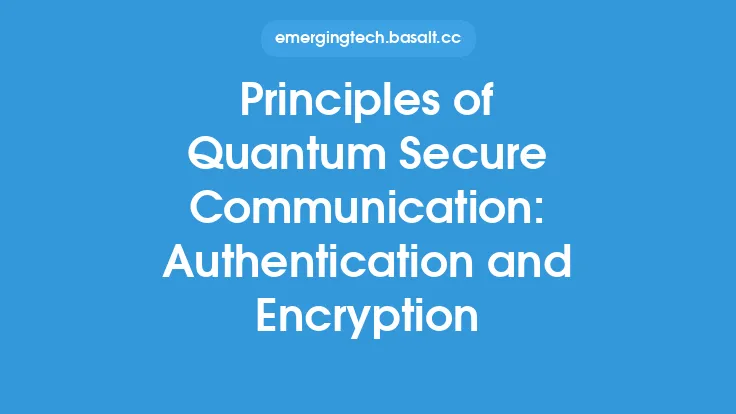The realm of quantum communication has witnessed significant advancements in recent years, with a primary focus on developing secure protocols for the exchange of sensitive information. Quantum cryptography, a subfield of quantum computing, has emerged as a promising solution for ensuring the confidentiality and integrity of communication. At its core, quantum cryptography exploits the principles of quantum mechanics to create unbreakable encryption methods, thereby safeguarding data against unauthorized access. This article delves into the world of secure quantum communication protocols, providing a comprehensive overview of the underlying principles, mechanisms, and techniques that enable secure data transmission.
Introduction to Quantum Cryptography
Quantum cryptography is based on the concept of quantum key distribution (QKD), which enables two parties to securely exchange cryptographic keys. These keys are then used for encrypting and decrypting messages, ensuring that only authorized parties can access the information. The security of QKD relies on the no-cloning theorem, which states that it is impossible to create a perfect copy of an arbitrary quantum state. This theorem ensures that any attempt to eavesdrop on the communication will introduce errors, making it detectable. Quantum cryptography protocols are designed to take advantage of this principle, providing a secure means of key exchange and, subsequently, encrypted communication.
Quantum Communication Protocols
Several quantum communication protocols have been developed, each with its unique characteristics and advantages. Some of the most notable protocols include BB84, B92, and Ekert91. The BB84 protocol, proposed by Charles Bennett and Gilles Brassard in 1984, is one of the earliest and most widely used QKD protocols. It relies on four non-orthogonal states to encode the key information, making it resistant to eavesdropping. The B92 protocol, introduced by Bennett in 1992, uses only two non-orthogonal states, simplifying the implementation while maintaining security. The Ekert91 protocol, proposed by Artur Ekert in 1991, utilizes entangled particles to encode the key, providing an additional layer of security.
Security Proofs and Analysis
The security of quantum communication protocols is typically analyzed using various proof techniques, including information-theoretic security and computational security. Information-theoretic security provides unconditional security, meaning that the protocol is secure against any adversary, regardless of their computational power. Computational security, on the other hand, relies on the hardness of certain computational problems, such as factoring large numbers or computing discrete logarithms. Security proofs for quantum communication protocols often involve demonstrating that any attempt to eavesdrop will introduce errors, which can be detected by the legitimate parties. This ensures that the protocol remains secure, even in the presence of an adversary.
Implementation and Practical Considerations
The implementation of secure quantum communication protocols requires careful consideration of various practical factors, including the quality of the quantum channel, the efficiency of the protocol, and the robustness against noise and errors. Quantum channels, such as optical fibers or free space, are prone to noise and attenuation, which can compromise the security of the protocol. To mitigate these effects, various techniques, such as error correction and noise reduction, are employed. Additionally, the efficiency of the protocol, measured in terms of the key generation rate and the secure communication rate, is crucial for practical applications.
Quantum Key Distribution Networks
Quantum key distribution networks (QKD-NETs) are designed to enable secure communication between multiple parties over long distances. These networks typically consist of a series of quantum repeaters, which amplify and re-transmit the quantum signals, allowing for the extension of the communication range. QKD-NETs can be classified into two main categories: trusted repeater networks and untrusted repeater networks. Trusted repeater networks rely on secure repeaters, which are assumed to be trustworthy, while untrusted repeater networks use untrusted repeaters, which may be compromised by an adversary. The security of QKD-NETs is a topic of ongoing research, with various protocols and techniques being developed to ensure the confidentiality and integrity of the communication.
Future Directions and Challenges
The field of secure quantum communication protocols is rapidly evolving, with new protocols and techniques being developed to address the challenges and limitations of existing methods. Some of the future directions and challenges include the development of high-speed QKD protocols, the implementation of QKD-NETs over long distances, and the integration of quantum cryptography with classical cryptography. Additionally, the emergence of new quantum technologies, such as quantum computing and quantum simulation, is expected to have a significant impact on the field of quantum cryptography, enabling new applications and use cases.
Conclusion
Secure quantum communication protocols have the potential to revolutionize the way we communicate sensitive information, providing unconditional security and confidentiality. The development of these protocols relies on a deep understanding of quantum mechanics and cryptography, as well as the ability to address practical challenges and limitations. As research in this field continues to advance, we can expect to see the widespread adoption of secure quantum communication protocols in various applications, including finance, government, and healthcare. The future of secure communication is quantum, and it is essential to stay informed about the latest developments and advancements in this exciting and rapidly evolving field.





